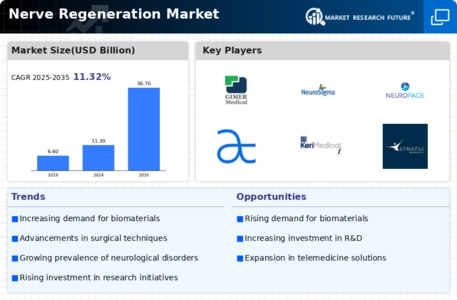Market Analysis
In-depth Analysis of Nerve Regeneration Market Industry Landscape
Venturing into developing economies represents a significant opportunity for various markets, particularly those that address health challenges. These economies often have underdeveloped research and development sectors, limiting their capacity to tackle emerging health issues effectively. In regions like Africa, despite a substantial demand for healthcare solutions, there is a reliance on imported medicines and other health technologies due to the sluggish growth of the healthcare industry. The economic challenges prevalent in these areas hinder the development of robust healthcare infrastructure.
According to the World Health Organization (WHO) statistics from 2017, a noteworthy 80% of the population affected by epilepsy resided in low- and middle-income countries. Similarly, Alzheimer's Research UK reported that 58% of all individuals with dementia were located in lower-middle-income countries, a percentage expected to climb to 68% by 2050. The prevalence of neurological disorders in developing countries, coupled with the vast untreated population, presents a substantial opportunity for the nerve regeneration market.
In developing economies, the healthcare landscape faces unique challenges characterized by limited resources, infrastructure gaps, and economic constraints. Despite the high demand for treatments, the slow growth of the healthcare sector in these regions underscores the need for innovative solutions to address prevalent health issues effectively. Neurological disorders, in particular, pose a significant burden on the population, and the existing treatment gaps offer a compelling opportunity for the nerve regeneration market to make a meaningful impact.
The underserved populations in developing economies create a niche for market players to introduce cutting-edge nerve regeneration technologies and therapies. By addressing the unmet healthcare needs in these regions, companies can contribute to improving health outcomes and enhancing the overall quality of life for individuals grappling with neurological disorders. The demand for innovative and accessible healthcare solutions in developing economies provides a strategic entry point for the nerve regeneration market to expand its reach and make a positive societal impact.
As the global healthcare landscape evolves, there is a growing recognition of the importance of inclusive and equitable healthcare access. The potential for market growth in developing economies lies not only in addressing the existing treatment gaps but also in fostering long-term partnerships and collaborations that contribute to building sustainable healthcare infrastructure. By aligning with the unique needs and challenges of developing economies, the nerve regeneration market can position itself as a key player in advancing healthcare solutions on a global scale.
In conclusion, the exploration of developing economies represents a promising avenue for the nerve regeneration market. The prevalence of neurological disorders, coupled with the underserved healthcare landscape, creates a conducive environment for market expansion. By introducing tailored solutions, fostering collaborations, and addressing the specific healthcare challenges in these regions, the nerve regeneration market can play a pivotal role in transforming healthcare outcomes and making a positive difference in the lives of individuals in developing economies.









Leave a Comment